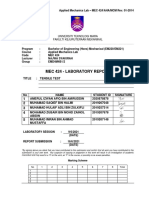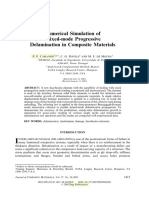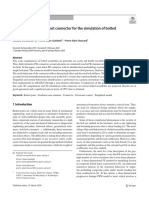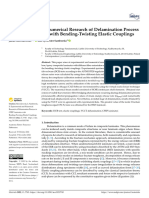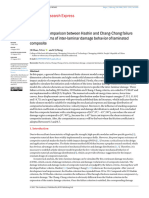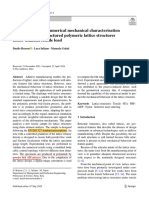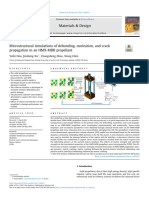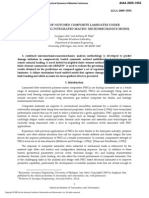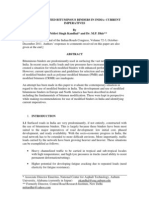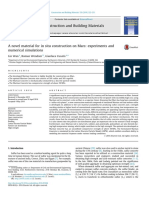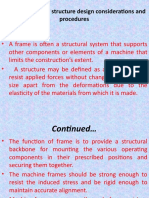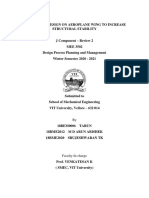Aiaa 2005 2320 744
Aiaa 2005 2320 744
Uploaded by
Junghyun AhnCopyright:
Available Formats
Aiaa 2005 2320 744
Aiaa 2005 2320 744
Uploaded by
Junghyun AhnOriginal Title
Copyright
Available Formats
Share this document
Did you find this document useful?
Is this content inappropriate?
Copyright:
Available Formats
Aiaa 2005 2320 744
Aiaa 2005 2320 744
Uploaded by
Junghyun AhnCopyright:
Available Formats
AIAA 2005-2320
AMERICAN INSTITUTE OF AERONAUTICS AND ASTRONAUTICS
1
Discrete Cohesive Zone Model To Simulate Static Fracture
In Carbon Fiber Textile Composites
De Xie
, Amit G. Salvi
, Anthony M. Waas
and Ari Caliskan
A discrete cohesive zone model (DCZM) is developed to simulate the
mode I and mixed mode fracture. For the mode I case, experimental results
generated using a modified single edge notched bend specimen of a 2D
triaxially braided composite (2DTBC) are used to verify the DCZM. The
2DTBC is modeled as an elastic one-parameter (a66) plastic continuum. The
plastic behavior of the 2DTBC is characterized by measuring a66. Fracture
toughness (GIC) as a function of crack extension is measured by a compliance
approach in the SENB tests. A previously developed mixed mode bending
(MMB) fracture test configuration is a useful method to generate fracture
envelopes for delamination failure of composites. The DCZM is used to
simulate mixed mode fracture of a unidirectional laminated composite loaded
using the MMB. The simulated results are compared with selected
experimental results and also verified for mesh sensitivity. It is shown that the
present DCZM is a versatile tool to study failure of a wide class of composite
materials.
Introduction
Several industrial sectors are currently exploring ways to utilize a variety of different
composite architectures for structural applications. These include continuous fiber pre-preg
based laminated composites, woven and braided textile composites, sandwich composites,
chopped fiber composites and low cost pultruded composites. Thus a need arises to develop a
comprehensive understanding of the mechanical response and subsequent fracture of these
different composite materials [1-15]. While the former is governed by an accurate knowledge of
structural stiffness, the latter falls into the category of structural integrity. Classical linear elastic
fracture mechanics (LEFM) based approaches and their extensions to account for material
nonlinearity are the most commonly used tools in a structural integrity and damage tolerance
analysis (SIDT). In SIDT, a structure with a flaw in the form of a crack is studied. The strain
energy release rate is computed by the virtual crack closure technique (VCCT) and compared to
Post Doctoral Student, University of Michigan, Ann Arbor, MI 48109.
Graduate Student, University of Michigan, Ann Arbor, MI 48109.
Professor, University of Michigan, Ann Arbor, MI 48109. Associate Fellow, AIAA.
Corresponding author.
Technical Expert, Vehicle Design Research & Advanced Engineering, Ford Motor Company,
Dearborn, MI 48121.
46th AIAA/ASME/ASCE/AHS/ASC Structures, Structural Dynamics & Materials Conference
18 - 21 April 2005, Austin, Texas
AIAA 2005-2320
Copyright 2005 by Anthony M. Waas. Published by the American Institute of Aeronautics and Astronautics, Inc., with permission.
AIAA 2005-2320
AMERICAN INSTITUTE OF AERONAUTICS AND ASTRONAUTICS
2
an appropriate critical value measured from tests [16-20]. With a "go no-go" type criterion, crack
growth is predicted. This is a computationally efficient approach for linear elastic materials.
However, for a wide class of fiber composites, significant material nonlinear effects are observed
at fracture initiation and subsequent growth [21, 22]. These nonlinearities may arise from matrix
micro-cracking, matrix plasticity, fiber/matrix interface decohesion, and fiber bridging. An
expedient way to deal with the effect of these nonlinearities is via a cohesive zone formulation
[23].
Cohesive zone modeling has been extensively used in conjunction with continuum
interface elements in finite element analysis (FEA) [24-43]. A historical account of the
developments in cohesive zone modeling is presented in [44-45]. The interface cohesive elements,
which are placed between the two surfaces that need to be decohered, are of zero thickness
(initial zero separation between the surfaces). Depending on the formulation, the stiffness matrix
of these interface elements may contain off-diagonal terms. In [46], a comprehensive overview of
the different interface elements and their finite element formulation is provided. In particular, it
is noted that smeared continuum cohesive elements (CCZM) lead to a fully populated stiffness
matrix (equation 19 of [46]) while a discrete cohesive zone model (DCZM) leads to a very sparse
interface element stiffness matrix (equation 27 of [46]). The main implication of this is the
attendant computational time and robustness in the resulting computations. For instance, if the
initial stiffness of the interface elements in the pre-cracking phase is chosen to be very large, then,
as pointed out in [45], depending on the spatial integration scheme used, the CCZM shows
spurious oscillations in the tractions. These oscillations are not an issue in DCZM, since the
DCZM embodies, in spirit, the idea of point-wise separation, as advanced in [23, 47]. A major
reason for both computational expediency and suppression of spurious oscillations can be
attributed to the fact that CCZM uses interpolated displacements for embedment in the traction
separation law, while essentially in the 1D DCZM models, the direct nodal displacement values
are used in the traction separation laws.
The central idea of the present DCZM is to treat the cohesive zone as a discrete bed of 1D
spring type elements [47-51]. A nonlinear discrete 1D element is placed between interfacial node
pairs to model cohesive interactions between surfaces instead of using continuum elements along
the crack path. In the present work, the DCZM adopted has three major differences compared to
that discussed in [47-51]. First, in [47-51], the crack tip strain field (the characteristic r
-1/2
singularity) is incorporated in the construction of the spring models. This adds additional
computational complication. Second, the DCZM presented here, is scalable according to the node
spacing (i.e. mesh size) as will be shown subsequently. Indeed, there is precedent to such an idea
as is presented in [52], in which the softening modulus is made a function of the element size.
Finally, the present DCZM algorithm is amenable to problems where substantial rotations of the
crack path can occur. In these instances, both geometric non-linearity and the local orientation of
the crack path to account for the proper local mode mixity, as has been discussed in [38], need to
be properly accounted for.
In this paper, the DCZM is used to simulate static mode I fracture of a 2DTBC and the
mixed-mode fracture of a unidirectional fiber composite. The 2DTBC is treated as an elastic
plastic orthotropic homogenized material. The effective mechanical properties (E11, E22, 12 and
G12) are measured by using ASTM (American Society for Testing and Materials) specified
standard material property tests. The plastic behavior of the material is characterized by carrying
out static off-axis compression tests, from which the plasticity parameter a66 is obtained.
AIAA 2005-2320
AMERICAN INSTITUTE OF AERONAUTICS AND ASTRONAUTICS
3
Mode I fracture tests are carried out to measure the fracture toughness (GIC) as a function
of crack growth. A compliance approach is used and it is found that the fracture toughness (GIC)
varies as the crack propagates in the specimen [22]. These variations are incorporated in the
simulations using the DCZM based interface elements; through a UEL (user element option)
within the commercial FEA software code ABAQUS. The simulated results agree very well with
test data and are not sensitive to the FEA mesh density. This is quite attractive from a
design/test/validation viewpoint and provides confidence in the use of DCZM for design
applications.
Interface Element based on DCZM
Figure 1 shows the schemes for DCZM and CCZM. CCZM uses conventional continuum
type elements while DCZM uses nonlinear two-noded axial elements. In related early work, these
elements are referred to as spring elements (see, [23, 48-49]) however, incorporating details of the
crack tip strain fields. As discussed earlier the present DCZM incorporates the nodal
displacements across the decohesion surfaces directly into the traction separation law, which in
turn is scalable with respect to the mesh size. The DCZM can be conveniently adopted into
commercial software codes, for instance, by directly using the nonlinear spring element option
provided by the ABAQUS
[51]. However, this must be handled with care particularly for
problems that have significant nonlinearity (geometric or different loading and unloading paths)
or for situations that present non-uniform fracture toughness. If the cohesive law varies along
the crack path, as in the present study, or a non-uniform mesh is used, the data preparation could
be cumbersome since the F- relation at each node pair should be defined individually. This
makes automation difficult. If the cohesive law has a complicated form rather than a simple
triangular shape, the data preparation for the F- relation could also be tedious.
In the present study, a discrete, two-noded interface element is introduced via a user
subroutine UEL in ABAQUS
[53] in order to develop a universal DCZM in a generalized
manner for simulating fracture. Figure 2 shows the element definition and node numbering
adopted. The element is placed in such a way that the nodes 1 and 2 are located at the crack tip.
Initially, node 1 coincides with node 2 and the gap between the two nodes, exaggerated in Figure
3, vanishes. Since the element has four nodes, the default instant displacement array for the
element is {U1, U2, U3, U4, U5, U6, U7 and U8}, which includes dummy nodes.
In order to apply cohesive law at the crack tip, a DCZM element is placed between nodes
"1" and "2". Nodes 3 and 4 are dummy nodes and do not have contributions to the stiffness
matrix. They are introduced to extract information for finite crack orientation angle () and the
effective length (a). This is particularly important for problems that have significant geometric
nonlinearity. Using Figure 2, it follows that,
( ) ( )
4 1
2 2
4 1 4 1
cos
x x
x x y y
=
+
..(1a)
( ) ( )
4 1
2 2
4 1 4 1
sin
y y
x x y y
=
+
..(1b)
AIAA 2005-2320
AMERICAN INSTITUTE OF AERONAUTICS AND ASTRONAUTICS
4
where (
1 1
, y x ) and (
4 4
, y x ) are the coordinates of nodes 1 and 4, respectively. If the
coordinates are updated by the corresponding displacement components, the instantaneous crack
orientation can be determined. The effective length (a) is
( ) ( )
2 2
4 3 4 3
1
2
a x x y y = + .. (2)
where (
3 3
, y x ) are the coordinates of node 3.
When the DCZM element is placed at the crack tip between nodes 1 and 2, the strain
energy stored is
2 2 1 1
E ,
1 1
2 2
( cos sin ) ( cos sin ),
1 1 2 3 4
( sin cos ) ( sin cos )
1 1 2 3 4
K X K Y
X Y
X U U U U
Y U U U U
= +
= + +
= + +
( (
(3)
where,
X
K and
Y
K are values of the stiffness in the local coordinate system ( Y X, ), see Figure 2.
They act to sense crack sliding and crack opening, respectively. The variation of the strain energy
is, therefore,
E
s s
T T
s s
= =
(
(
U U U U
(4)
where
cos sin 0 cos sin
sin cos 0 sin cos
X
T
s s
Y
K
K
= =
( ( (
( ( (
T T (5a)
1
2
3
4
U
U
U
U
=
`
)
U ;
1
2
3
4
U
U
U
U
=
`
)
U (5b)
K is the stiffness matrix for the element in the global coordinate system, and is required for the
user defined element subroutine in ABAQUS
. U is the displacement vector related to nodes
1 and 2. The nodal opening at the crack tip is:
1 3 2 4
( ) sin ( ) cos U U U U = + (6)
In the present study, a triangular cohesive law ([23], [47-49]) is used as shown in Figure 3.
Based on the energy required to create a new crack surface, we have,
AIAA 2005-2320
AMERICAN INSTITUTE OF AERONAUTICS AND ASTRONAUTICS
5
1
2
c m IC
G = (7)
where GIC is the fracture toughness of the material that can be measured through tests. m, and c
are the maximum nodal opening and the critical cohesive stress, respectively. Once one of them is
chosen, the other is determined by equation (7) and thus the cohesive law is completely fixed. In
this paper, we choose m as the cohesive parameter. The numerical value of m is determined via
trials until the variation of m does not affect the fracture load significantly. Once m is chosen, the
critical value for the cohesive force in the DCZM element is calculated as
2
IC
c c
m
G B a
F B a
= = (8)
where, B is the out-of-plane thickness of the specimen. Since the spacing of the DCZM element
depends on the coordinates of the nodes, Fc depends on the mesh size (note c is independent of
element spacing). The critical opening (c) is calculated by
c
c
y
F
K
= (9)
where
Y
K is the initial stiffness of the DCZM element which is selected to be a very high value
relative to the stiffness of the bridged material.
To apply the triangular cohesive law, when
c
,
Y
K is set to be a very large number
to ensure that the crack is initially closed. In numerical implementation, this value usually is
chosen to be three orders of magnitude larger than the major Youngs modulus of the specimen.
When
m c
< < , the softening part of the cohesive zone,
Y
K is determined as
=
c
Y
m c
F
K (10)
Finally, when
m
, the DCZM element fails completely, and 0 =
Y
K .
For mixed mode failure, the DCZM implementation is as illustrated in Figure 4. Two
one-dimensional cohesive elements are placed along the intended crack path. Both elements are
attached to the same two nodes on the crack flanges. Once the following criterion is satisfied,
1
I II
IC IIC
G G
G G
+ (11)
both 1D elements are completely removed, and the crack is assumed to have advanced to that
location. Note that the DCZM implementation is not tied to the form of the failure criterion.
Equation (11) is chosen in the present study based on past experience and success in using this
for failure prediction [54].
AIAA 2005-2320
AMERICAN INSTITUTE OF AERONAUTICS AND ASTRONAUTICS
6
Application of DCZM to predict mode I fracture of 2DTBC
Figure 5 shows a schematic of the SENB test set-up. The front surface of the specimen is
lightly coated with a diffusely reflective white surface to improve image quality. This surface is
illuminated with a He-Ne laser. During crack growth, extensive fiber bridging is clearly observed,
see inset of Figure 5. Further details of the experiments and the experimental data are given
elsewhere [22, 55]. Figure 6 presents the test results for mode I fracture toughness (GIC) measured
using the compliance method. It is seen that the fracture toughness varies with respect to the
crack extension during the initial stages of crack growth and then attains an approximately
constant plateau value. It is noted that, the GIC value that is measured in the experiments is a
through the thickness averaged fracture energy. The position of the crack path (with respect to
the braid microstructure and with respect to the details of the stacking) varies from specimen to
specimen. It is not unusual to find variation in the GIC values (for the through the thickness
averaged) in this class of composites. On the other hand for a single layer of the textile composite
and for a crack path position that is consistent with respect to the textile architecture, the GIC
value can be obtained more consistently and with less scatter.
Due to symmetry, only one half of the fracture specimen is modeled with FEA, as shown
in Figure 7. Three different meshes corresponding to different numbers of elements (1610, 6570
and 26280 elements, respectively), are used to study the mesh sensitivity of the DCZM [55]. The
specimen is modeled with CPS4 elements in ABAQUS with mechanical properties listed in Table
1. The load application roller and the support rollers are modeled by CPS3 elements with
mechanical properties of steel. Contact surfaces are applied between the rollers and the specimen.
The load is applied in the form of displacement control () at the center of the loading
roller. The force (P) is taken as the contact force between loading roller and the upper surface of
the specimen and, therefore, it is comparable to the force measured from the load cell in
experiments.
The mechanical characterization of the 2DTBC is reported in [55]. It is found that the
2DTBC can be modeled as a orthotropic elastic plastic solid with a one parameter plastic potential
[55], with the a66 parameter = 1.2. A user defined material subroutine UMAT is used to
accommodate the orthotropic plastic model. This is done in conjunction with the user element
subroutine for the DCZM. The P vs. curves for this case is shown in Figure 8. Mesh (b) and
mesh (c) prediction are very close to each other, and the difference between the two can be
neglected. It is clear that the DCZM results have converged with respect to mesh size. In general,
the simulated results by DCZM agree very well with the test data. In using the present DCZM, no
numerical convergence problems are encountered. The method did not show any significant
mesh sensitivity. Table 2 summarizes the CPU times used for the simulations. Each analysis job is
run on a SunBlade 100 machine with one processor (UNIX environment). For the mesh with the
least number of elements without plasticity, the CPU consumed for a complete analysis is
approximately ten minutes. This is a great reduction in time compared to similar runs with
CCZM which can take CPU times on the order of hours.
Application of DCZM to predict mixed mode fracture of MMB
AIAA 2005-2320
AMERICAN INSTITUTE OF AERONAUTICS AND ASTRONAUTICS
7
The MMB set-up was introduced by Reeder and Crews [57] to obtain mixed-mode fracture data
using a relatively simple test machine and test fixture. The configuration used in the MMB is
shown in Figure 9. An edge cracked unidirectional composite beam is subjected to load as shown.
The edge crack splits the beam of thickness 2h into two beams of thickness h. By changing the
load application point, a variety of mixed-mode conditions can be implemented. An analytical
solution for the P vs. relation corresponding to Figure 9 is formulated in [25]. In order to
compare the DCZM solution with the analytical solution in [25], the following geometrical
dimensions and material properties are used in the analysis;
L=50mm; e=50mm; a0=30mm; h=1.5mm;
B=10.0mm, E=13510
3
MPa; v=0.24; GIC=GIIC=4.0N/mm
Figure 10 shows a comparison of results between the analytical solution and the FEA
results using the DCZM for different pairs of cohesive strength (1c, 2c). As the mode I and mode
II cohesive strengths increase, the present DCZM results approach the analytical results. The
analytical results are based only on LEFM and has no strength information in assessing failure.
On the other hand, the DCZM incorporates both, a critical strength and a critical energy release
rate, in assessing failure. No convergence problems are encountered in the implementation. This
indicates that the implementation of the mixed-mode DCZM, as proposed herein, is indeed
satisfactory for this class of problems.
Conclusions
In this paper, results from a novel discrete cohesive zone model (DCZM) to simulate
mode I and mixed mode fracture have been presented. For the mode I case, experimental results
generated using a modified single edge notched bend specimen of a 2D triaxially braided
composite (2DTBC) are used to verify the DCZM. The mixed mode bending (MMB) fracture test
configuration developed by Reeder and Crews [57] is used as the configuration to study mixed
mode fracture. In both cases, it is seen that the DCZM is able to capture the essential features of
the fracture problems. The DCZM, as presented here, is easy to implement and is
computationally efficient when compared to other cohesive zone modeling approaches. Because
the DCZM uses a point-wise discrete approach to simulate fracture and because the FEA is
essentially a discrete solver, the two approaches are compatible and this is reflected in the
computational expediency in the numerical implementation of the DCZM.
Acknowledgements
The authors wish to thank the DOE program management team and the Board and staff
of the Automotive Composites Consortium-Energy Management Working Group. This work
was sponsored by the Automotive Composites Consortium and the US Department of Energy,
Office of Transportation Technologies, Office of Advanced Automotive Technologies,
Lightweight Materials Program under Cooperative Agreement number FC05-02OR22910). DX,
AGS and AMW wish to thank the Aerospace Engineering Department at the University of
Michigan.
References
AIAA 2005-2320
AMERICAN INSTITUTE OF AERONAUTICS AND ASTRONAUTICS
8
1. Chou TW, Microstructural Design of Fiber Composites, Cambridge University Press,
Cambridge, 1992.
2. Poe CC, Dexter HB and Raju IS, Review of the NASA textile composites research, Journal of
Aircraft, 36 (1999): 876-884.
3. Ramani K and Dai HM, Design and process for preformed woven, knitted, and braided
thermoplastic composite reinforced arrester, Journal of Composite Materials, 36(2002): 2357-
2372.
4. Huang ZM, Modeling and characterization of bending strength of braided fabric reinforced
laminates, Journal of Composite Materials, 36(2002): 2537-2566.
5. Huang ZM and Ramakrishna S, Modeling inelastic and strength properties of textile
laminates: a unified approach, Composites Sciences and Technology, 63(2003): 445-466.
6. Byun JH, The analytical characterization of 2-D braided textile composites, Composites
Science and Technology, 60(2000): 705-716.
7. Tang XD and Whitcomb JD, Progressive failure behaviors of 2D woven Composites, Journal
of Composite Materials, 37(2003): 1239-1259.
8. Quek SC, Waas AM, Shahwan KW and Agaram V, Analysis of 2D triaxial flat braided textile
composites, International Journal of Mechanical Sciences, 45(2003): 1077-1096.
9. Song SJ and Waas AM, Response and stability of woven composites under compressive loads,
ICCES'04, Portugal, July 2004.
10. Glaessgen EH, Pastore CM, Griffin OH and Birger A, Geometrical and finite element
modeling of textile composites, Composites: Part B, 27(1996): 43-50.
11. Quek SC, Waas AM, Shahwan KW and Agaram V, Compressive response and failure of
braided textile composites: Part 1- experiments, International Journal of Non-linear
Mechanics, 39(2004): 635-648.
12. Quek SC, Waas AM, Shahwan KW and Agaram V, Compressive response and failure of
braided textile composites: Part 2- computations, International Journal of Non-linear
Mechanics, 39(2004): 649-663.
13. Noh JH and Whitcomb JD, Progressive damage simulation of thick viscoelastic laminate with
homogenization technique, Mechanics of Advanced Materials and Structures, 10 (2003): 285-
302.
14. Woo K and Whitcomb JD, Three-dimensional failure analysis of plain weave textile
Composites using a global/local finite element method, Journal of Composite Materials,30
(1996): 984-1003.
15. Quek SC, Waas AM, Hoffman J and Agaram V, The crushing response of braided and CSM
glass reinforced composite tubes, Composite Structures, 52(2001): 103-112.
16. Rybicki EF and Kanninen MF, Finite-element calculation of stress intensity factors by a
modified crack closure integral, Engineering Fracture Mechanics, 9 (1977): 931-938.
17. Kutlu Z and Chang FK. Modeling compressive failure of laminated composites containing
multiple through-the-width cracks. Journal of Composite Materials, 26(1992): 350-387.
18. Tsai JL, Guo C and Sun CT. Dynamic crack fracture toughness in unidirectional polymeric
composites. Composites Science and Technology, 61(2001): 87-94.
19. Xie D and Biggers, Jr. SB, Progressive crack growth analysis using interface element based on
the virtual crack closure technique, Finite Elements in Analysis and Design, in preparation.
20. Xie D, Waas AM, Shahwan KW, Schroeder JA and Boeman RG, Computation of energy
release rates for kinking cracks based on virtual crack closure technique, CMES: Computer
Modeling in Engineering & Sciences, 6(2004): 515-524.
AIAA 2005-2320
AMERICAN INSTITUTE OF AERONAUTICS AND ASTRONAUTICS
9
21. Salvi AG, Chung J, Waas AM and Caliskan A, Strain-rate effects on unidirectional carbon-
fiber composites, AIAA Journal, 41 (2003): 2020-2028.
22. Salvi AG, Waas AM and Caliskan A, Static and dynamic fracture of 2DTBC, in preparation
for publication.
23. Ungsuwarungsri T and Knauss WG, The Role of Damage-Softened Material Behavior in the
fracture of composites and adhesives, International Journal of Fracture, 35(1987): 221-241. See
also Ph.D. thesis, 1985, Aeronautics Department, Caltech, Pasadena, CA.
24. Xu XP and Needleman A, Numerical simulation of fast crack growth in brittle solids, Journal
of the Mechanics and Physics of Solids, 42(1994): 1397-1434.
25. Mi Y, Crisfield MA, Davis GAO and Helweg HB, Progressive delamination using interface
elements, Journal of Composites, 32(1998): 1246-1272.
26. de Borst R, Numerical aspect of cohesive zone models, Engineering Fracture Mechanics,
70(2003): 1943-1961.
27. Yang QD and Thouless MD, Mixed-mode fracture analyses of plastically-deforming adhesive
joints, International Journal of Fracture, 110 (2001): 175-187.
28. Yang QD, Thouless MD and Ward SM, Numerical simulations of adhesively-bonded beams
failing with extensive plastic deformation, Journal of the Mechanics and Physics of Solids, 47
(1999): 1337-1353.
29. Li S, Wang J and Thouless MD, The effects of shear on crack in layered materials, Journal of
the Mechanics and Physics of Solids, 52(2004): 193-214.
30. Li S, Thouless MD, Waas AM, Schroeder JA and Zavattieri PD, Mode-I cohesive-zone models
for fracture of an adhesively bonded polymer-matrix Composite, Composites Science and
Technology, accepted to appear, 2004.
31. Li S, Thouless MD, Waas AM, Schroeder JA and Zavattieri PD, Use of cohesive-zone models
to analyze fracture of a fiber-reinforced polymer-matrix Composite, Composites Science and
Technology, accepted to appear, 2004.
32. Zavattieri PD, Raghuram PV and Espinosa HD, A computational model of ceramic
microstructures subjected to multi-axial dynamic loading, Journal of the Mechanics and
Physics of Solids, 49 (2001): 27-68.
33. Espinosa HD, Zavattieri PD and Dwivedi SK, A finite deformation continuum discrete model
for the description of fragmentation and damage in brittle materials, Journal of the
Mechanics and Physics of Solids, 46 (1998): 1909-1942.
34. de Moura MFSF, Goncalves JPM, Marques AT and de Castro PMST, Prediction of
compressive strength of carbon-epoxy laminates containing crack by using a mixed-mode
damage model, Composite Structures, 50(2000): 1415-1438.
35. Camacho GT and Ortiz M, Computational modeling of impact demage in brittle materials,
International Journal of Solids and Structures, 33(1996): 2899-2938.
36. Zou Z, Reid SR and Li S, A continuum damage model for delaminations in lamianted
Composites, Journal of the Mechanics and Physics of Solids, 51(2003): 333-356.
37. Zhou F and Molinari JF, Dynamic crack propagation with cohesive elements: a methodology
to address mesh dependency, International Journal for Numerical Methods in Engineering,
59(2004): 1-24.
38. El-Sayed S and Sridharan S, Cohesive models for predicting delamination growth and crack
kinking in sandwich structures, International Journal of Fracture, 117(2002): 63-84.
39. Reedy ED, Mello FJ and Guess TR, Modeling the initiation and growth of delaminations in
composite structures, Journal of Composite Materials, 31 (1997): 812-831.
AIAA 2005-2320
AMERICAN INSTITUTE OF AERONAUTICS AND ASTRONAUTICS
10
40. Tvergaard V and Hutchinson JW, The relation between crack growth resistance and fracture
parameters in elastic-plastic solids, Journal of the Mechanics and Physics of Solids, 40(1992):
1377-1397.
41. Goyal V and Klug J, Interphasic formulation for the prediction of delamination, AIAA-2004-
1845, 45
th
AIAA/ASME/ASCE/AHS/ASC Structures, Structural Dynamics and Materials
conference, Palm Spring, Ca, April 19-22, 2004.
42. Goyal V and Johnson E, Cohesive-Decohesive interfacial constitutive law for the analyses of
fatigue crack initiation and growth, AIAA-2004-1678, 44
th
AIAA/ASME/ASCE/AHS/ASC
Structures, Structural Dynamics and Materials conference, Norfolk, Virginia, April 7-10, 2003.
43. Goyal-Singhal V, Jaunky N, Johnson E and Ambur D, Intralaminar and interlaminar
progressive failure analyses of composite panels with circular cutouts, AIAA-2004-1745, 43
rd
AIAA/ASME/ASCE/AHS/ASC Structures, Structural Dynamics and Materials conference,
Denver, Colorado, April 22-25, 2002.
44. de Borst R, Some recent issues in computational failure mechanics, International Journal for
Numerical Methods in Engineering, 52(2001): 63-95.
45. de Borst R, Numerical aspects of cohesive-zone models, Engineering Fracture Mechanics,
(2003).
46. Schellekens J C J and de Borst R, On the numerical integration of interface elements,
International Journal for Numerical Methods in Engineering, 36(1993): 43-66.
47. Song SJ and Waas AM, Energy-based mechanical model for mixed-mode failure of laminated
composites, AIAA Journal, 33 (1995): 739-745
48. Song SJ and Waas AM, Mode-I failure of laminated polymeric composites, Engineering
Fracture Mechanics, 49 (1994): 17-27.
49. Song SJ and Waas AM, A spring foundation model for mode-I failure of laminated
composites based on an energy criterion, Journal of Engineering Materials and Technology,
116 (1994): 512-516.
50. Shahwan KW and Waas AM, Non-self-similar decohesion along a finite interface of
unilaterally constrained delaminations, Proceedings of the Royal Society of London. Series A:
Mathematical and Physical Sciences, 453 (1997): 515-550.
51. Sun C, Waas AM, Li S, Thousless MD, Schroder JA and Zavattieri PD, Out-of-plane fracture
characterization of a composite using discrete cohesive zone model: experiments and
analysis, in preparation.
52. Pietruszczak S and Mroz Z, Finite element analysis of deformation of strain softening
materials, International Journal for Numerical Methods in Engineering, 17 (1981): 327-334.
53. ABAQUS Inc., ABAQUS User Manual, version 6.3, Pawtucket, RI.
54. Xie D, Waas AM, Shahwan KW, Boeman RG and Schroeder JA, Fracture criteria for kinking
cracks in triple material bonded joints, Engineering Fracture Mechanics, accepted.
55. Xie D, Salvi AG, Waas AM, Caliskan A, Discrete cohesive zone model to study static fracture
in a plate of textile braided carbon fiber composites, International Journal for Numerical
Methods in Engineering, submitted.
56. Sun CT and Chen JL, A plastic potential function suitable for anisotropic fiber composites,
Journal of Composite Materials, 27(1993): 1379-1390.
57. Reeder JR and Crews JR, Mixed-mode bending for delamination testing, AIAA Journal,
28(1990):1270-1276.
AIAA 2005-2320
AMERICAN INSTITUTE OF AERONAUTICS AND ASTRONAUTICS
11
Table 1. Effective Mechanical Properties
E11(GPa) E22(GPa) 12 G12(GPa)
68.53 10.78 0.36 4.52
Table 2. CPU consumed by DCZM (unit: second)*
Conditions Mesh (a)
1610 elements
Mesh(b)
6570 elements
Mesh (c)
26280 elements
GIC=57N/mm, No a66 506 2236 10277
GIC=f(a), No a66 499 2243 10103
GIC=f(a) and a66 1227 6446 31927
*SunBlade 100 machine, UNIX
AIAA 2005-2320
AMERICAN INSTITUTE OF AERONAUTICS AND ASTRONAUTICS
12
Figure 1: Scheme of DCZM and CCZM
X
Y
DCZM
CCZM
AIAA 2005-2320
AMERICAN INSTITUTE OF AERONAUTICS AND ASTRONAUTICS
13
Figure 2: DCZM interface elements for slant crack lying in (X, Y) plane
1
2
3
4
a
X
Y
Y
X
AIAA 2005-2320
AMERICAN INSTITUTE OF AERONAUTICS AND ASTRONAUTICS
14
Figure 3: Triangle type cohesive law used in the present study
c
G
IC
c
m
AIAA 2005-2320
AMERICAN INSTITUTE OF AERONAUTICS AND ASTRONAUTICS
15
Figure 4: Fracture criterions for mixed mode fracture in DCZM
1
(MPa)
1c
G
IC
1(mm)
1c
1m
G
I
2
(MPa)
2c
G
IIC
2(mm)
2c
2m
G
II
AIAA 2005-2320
AMERICAN INSTITUTE OF AERONAUTICS AND ASTRONAUTICS
16
Figure 5: Experimental setup for fracture toughness tests.
S St te ee el l B Ba as se e
M MT TS S A Ac ct tu ua at to or r
S Sp pe ec ci im me en n
Top Loading Pin
I In ni it ti ia al l N No ot tc ch h
Crack
Propagation
AIAA 2005-2320
AMERICAN INSTITUTE OF AERONAUTICS AND ASTRONAUTICS
17
Figure 6: Fracture toughness varied with crack extension averaged from test data
Crack extension, a (mm)
G
I
C
(
N
/
m
m
)
G
IC
=68N/mm
A
GIC=25N/m
B
C
G
IC
=57N/mm
AIAA 2005-2320
AMERICAN INSTITUTE OF AERONAUTICS AND ASTRONAUTICS
18
Figure 7: Single edge notch bend specimen to measure fracture toughness1610 elements
7
3
m
m
152 mm
178 mm
P,
AIAA 2005-2320
AMERICAN INSTITUTE OF AERONAUTICS AND ASTRONAUTICS
19
Figure 8: Comparison between test data and simulated results by DCZM (GIC=f(a) and a66)
0 1 2 3
4
5 6
7 8
0
5
10
15
20
25
30
P
(
k
N
)
(mm)
35
Number of Elements
(a) 1610
(b) 6570
(c)26280
Test Data
Simulated
by DCZM
AIAA 2005-2320
AMERICAN INSTITUTE OF AERONAUTICS AND ASTRONAUTICS
20
Figure 9: Mixed-Mode Bending (MMB) Test Apparatus
a
0
P
2L
L
e
2h
AIAA 2005-2320
AMERICAN INSTITUTE OF AERONAUTICS AND ASTRONAUTICS
21
Figure 10: Comparison of analytical solution and DCZM for MMB
0 5 10 15 20 25 30
0
40
80
120
160
200
Deflection, (mm)
L
o
a
d
,
P
(
N
)
1c
=10MPa
2c
=20MPa
1c
=40MPa
2c
=40MPa
Analytical
Solution
You might also like
- Tensile Test Experiment Lab ReportDocument78 pagesTensile Test Experiment Lab ReportAmerul izwan Amiruddin88% (8)
- CALCULATIONS Pad Eye DesignDocument5 pagesCALCULATIONS Pad Eye DesignVijay Verma100% (1)
- Plastic Strain Based Criterion For Failure Predictions of Short Fiber Reinforced Plastics at Structural LevelDocument12 pagesPlastic Strain Based Criterion For Failure Predictions of Short Fiber Reinforced Plastics at Structural LevelnapoleonmNo ratings yet
- My Paper 2Document16 pagesMy Paper 2pranjyoti227No ratings yet
- 2018-SAoE-ABAQUS-XFEM To Study The Fracture of 3D Printed Polymers Considering Layer InterfacesDocument12 pages2018-SAoE-ABAQUS-XFEM To Study The Fracture of 3D Printed Polymers Considering Layer InterfacesVipin DasNo ratings yet
- Development of A 3D Finite Element Model at Mesoscale For The - 2022 - CompositeDocument12 pagesDevelopment of A 3D Finite Element Model at Mesoscale For The - 2022 - Compositesaif ullahNo ratings yet
- Cohesive Zone ModelingDocument13 pagesCohesive Zone ModelingAmbalam NandhuNo ratings yet
- Published Uncertainty of Concrete Strength in Shear and Flexural Behavior of Beams Using Lattice ModelingDocument20 pagesPublished Uncertainty of Concrete Strength in Shear and Flexural Behavior of Beams Using Lattice Modelinghamed sadaghianNo ratings yet
- FB 240615034148Document96 pagesFB 240615034148紀俞揚No ratings yet
- Numerical Simulation of Mixedmode Progressive Delamination in Composite MaterialsDocument24 pagesNumerical Simulation of Mixedmode Progressive Delamination in Composite Materials蕭佩杰No ratings yet
- 1 s2.0 S0013794421002459 MainDocument16 pages1 s2.0 S0013794421002459 MainvinhtungbkNo ratings yet
- Finite Elements in Analysis and Design: Ramzi Askri, Christophe Bois, Hervé Wargnier, Julie LecomteDocument11 pagesFinite Elements in Analysis and Design: Ramzi Askri, Christophe Bois, Hervé Wargnier, Julie LecomteShashwatamNo ratings yet
- Shear Characterization of Adhesive Layers by Advanced Optical TechniquesDocument14 pagesShear Characterization of Adhesive Layers by Advanced Optical TechniquesyasminaNo ratings yet
- 2021-Virtual Characterization of Nonlocal Continuum Damage Model Parameters Using A High Fidelity Finite Element ModelDocument16 pages2021-Virtual Characterization of Nonlocal Continuum Damage Model Parameters Using A High Fidelity Finite Element Model1309683669No ratings yet
- Positesa.2016.12.026 Numerical Simulation of Progressive Damage and Failure in Composite Laminates Using XFEM CZM Coupled ApproachDocument11 pagesPositesa.2016.12.026 Numerical Simulation of Progressive Damage and Failure in Composite Laminates Using XFEM CZM Coupled Approachhamid rezaNo ratings yet
- (3 - 5) Adherend Thickness Effect On The Tensile Fracture Toughness of ADocument8 pages(3 - 5) Adherend Thickness Effect On The Tensile Fracture Toughness of Ashahbazbegian.uniNo ratings yet
- Automated Image Based Geometric Modelling of Thick Laminat - 2023 - NDT - E InteDocument15 pagesAutomated Image Based Geometric Modelling of Thick Laminat - 2023 - NDT - E IntemaheshNo ratings yet
- Simulation of Pre-Stressed Slabs Using Abaqus CDP Material ModelDocument10 pagesSimulation of Pre-Stressed Slabs Using Abaqus CDP Material ModelDima OvsiiNo ratings yet
- Localizing Gradient Damage Model Based On A Decomposition of Elastic Strain Energy DensityDocument21 pagesLocalizing Gradient Damage Model Based On A Decomposition of Elastic Strain Energy DensityhungNo ratings yet
- Composites Science and Technology: A.M. Elmarakbi, N. Hu, H. FukunagaDocument9 pagesComposites Science and Technology: A.M. Elmarakbi, N. Hu, H. Fukunagaelenita_albNo ratings yet
- A Nonlinear Finite Element Connector For The Simulation of Bolted AssembliesDocument18 pagesA Nonlinear Finite Element Connector For The Simulation of Bolted AssembliesTouts ToutsNo ratings yet
- Open Hole ReferenceDocument18 pagesOpen Hole ReferenceHanzla ZubairNo ratings yet
- 12-polymers-14-02807-v2Document16 pages12-polymers-14-02807-v2zahidesadcinkaNo ratings yet
- Computational Models For The Stress Analysis of Metal Composite Overwrapped Pressure Vessels - Andrey Burov2016Document5 pagesComputational Models For The Stress Analysis of Metal Composite Overwrapped Pressure Vessels - Andrey Burov2016Hiến Đinh VănNo ratings yet
- Delamination With AbaqusDocument13 pagesDelamination With AbaqusSchmetterling TraurigNo ratings yet
- Grodzki Lukaszewicz PDFDocument9 pagesGrodzki Lukaszewicz PDFFabrice NebesseNo ratings yet
- Determination of The J IntegralDocument15 pagesDetermination of The J IntegralJamalNo ratings yet
- Evaluation of The Elastic Behavior of Multiaxis 3d-Woven Preforms by Numerical ApproachDocument10 pagesEvaluation of The Elastic Behavior of Multiaxis 3d-Woven Preforms by Numerical ApproachIsmail BayraktarNo ratings yet
- 2006 - An Engineering Solution For Mesh Size Effects in The Simulation of Delamination Using Cohesive Models - TuronDocument18 pages2006 - An Engineering Solution For Mesh Size Effects in The Simulation of Delamination Using Cohesive Models - TuronTousif AhmedNo ratings yet
- Modeling Delamination Growth in Laminated Composites: F. Shen, K.H. Lee, T.E. TayDocument13 pagesModeling Delamination Growth in Laminated Composites: F. Shen, K.H. Lee, T.E. TaybnidhalNo ratings yet
- Mechanical Characterisation and Simulation of the Tensile Behaviour of Polymeric Additively Manufactured Lattice StructuresDocument17 pagesMechanical Characterisation and Simulation of the Tensile Behaviour of Polymeric Additively Manufactured Lattice Structuresjaysrvstv1No ratings yet
- (3 - 11) Experimental and Numerical Research of Delamination ProcessDocument14 pages(3 - 11) Experimental and Numerical Research of Delamination Processshahbazbegian.uniNo ratings yet
- Numerical Comparison Between Hashin and Chang-ChanDocument17 pagesNumerical Comparison Between Hashin and Chang-Chancanvadesigner69No ratings yet
- Kumar 2015Document16 pagesKumar 2015donaNo ratings yet
- Experimental and numerical mechanical characterisation of additively manufactured polymeric lattice structures under uniaxial tensile loadDocument12 pagesExperimental and numerical mechanical characterisation of additively manufactured polymeric lattice structures under uniaxial tensile loadjaysrvstv1No ratings yet
- Use of A Cohesive-Zone Model To Analyze The Fracture of A Fiber-Reinforced Polymer-Matrix CompositeDocument13 pagesUse of A Cohesive-Zone Model To Analyze The Fracture of A Fiber-Reinforced Polymer-Matrix CompositeSundeep Krishna SiripurapuNo ratings yet
- An Interface Element For The Simulation of Delamination in Unidirectional Fiber-Reinforced Composite LaminatesDocument19 pagesAn Interface Element For The Simulation of Delamination in Unidirectional Fiber-Reinforced Composite LaminatesKamal ShayedNo ratings yet
- A Gradient-Regularized Coupled Damage-Plasticity Microplane Model For Concrete - Like MaterialsDocument6 pagesA Gradient-Regularized Coupled Damage-Plasticity Microplane Model For Concrete - Like MaterialsKamil KozłowskiNo ratings yet
- Microplane Anysy Model1Document6 pagesMicroplane Anysy Model1KILARUDIVYANo ratings yet
- Isogeometric Analysis of Shear Refined Delaminated Composite Beams Using Dimensionally Reduced Beam Sectional Analysis. Esmaeel Ghafari, 2019Document11 pagesIsogeometric Analysis of Shear Refined Delaminated Composite Beams Using Dimensionally Reduced Beam Sectional Analysis. Esmaeel Ghafari, 2019BenjaminNo ratings yet
- CAE Fatigue and Fracture Seminar - CZM For WebDocument21 pagesCAE Fatigue and Fracture Seminar - CZM For WebdamnkaushikNo ratings yet
- Mechanical Properties of Triply Periodic Minimal Surface Based Lattices Made by Polyjet PrintingDocument7 pagesMechanical Properties of Triply Periodic Minimal Surface Based Lattices Made by Polyjet Printingxu.dachong59No ratings yet
- 1 s2.0 S0020740323007178 MainDocument49 pages1 s2.0 S0020740323007178 MainsobhanNo ratings yet
- VCCT Vs CohesiveDocument8 pagesVCCT Vs Cohesiveavenasha100% (1)
- Nazemzadeh (2022) - Computing The Bond Strength of 3D Printed Polylactic Acid Scaffolds in Mode I and II Using Experimental Tests, Finite Element Method and Cohesive Zone ModelingDocument17 pagesNazemzadeh (2022) - Computing The Bond Strength of 3D Printed Polylactic Acid Scaffolds in Mode I and II Using Experimental Tests, Finite Element Method and Cohesive Zone ModelingIgnacio VillaNo ratings yet
- Materials 13 02422 v2Document26 pagesMaterials 13 02422 v2Luca CoralloNo ratings yet
- Selecting Material Parameters in Abaqus For Cohesive ElementsDocument17 pagesSelecting Material Parameters in Abaqus For Cohesive Elementsismailovic2No ratings yet
- Aiaa 1899 997Document8 pagesAiaa 1899 997doolyiiNo ratings yet
- Composite DelaminationDocument13 pagesComposite DelaminationPravinkumarGhodakeNo ratings yet
- A Simple and Robust Approach For 2D Simulation of Reinforced C 2021 StructurDocument16 pagesA Simple and Robust Approach For 2D Simulation of Reinforced C 2021 StructurAswin R CNo ratings yet
- A Modelling Framework For Composites Containing 3D ReinforcementDocument25 pagesA Modelling Framework For Composites Containing 3D ReinforcementXiaodong LiNo ratings yet
- A 3D Mesoscale Damage-Plasticity Approach For Masonry Structures Under Cyclic LoadingDocument21 pagesA 3D Mesoscale Damage-Plasticity Approach For Masonry Structures Under Cyclic LoadingYU NIENo ratings yet
- Chen (2014) - An Extended Cohesive Damage Model With A Length Scale in Fracture Analysis of Adhesively Bonded JointsDocument12 pagesChen (2014) - An Extended Cohesive Damage Model With A Length Scale in Fracture Analysis of Adhesively Bonded JointsIgnacio VillaNo ratings yet
- Hyperelastic Model For Large Deformation Analyses of 3D Interlock Composites PreformsDocument9 pagesHyperelastic Model For Large Deformation Analyses of 3D Interlock Composites PreformsLouis GrouNo ratings yet
- DIC Digital Image Correlation Method in The Resear PDFDocument9 pagesDIC Digital Image Correlation Method in The Resear PDFJ SREEJANo ratings yet
- Comparative Study Between Stressed Skin Effect ofDocument10 pagesComparative Study Between Stressed Skin Effect ofthelga_899800No ratings yet
- Fracture Analysis of Adhesive Joints Using Intrinsic Cohesive Zone ModelsDocument8 pagesFracture Analysis of Adhesive Joints Using Intrinsic Cohesive Zone ModelsMin-Sung KimNo ratings yet
- 1 s2.0 S0167844223001544 MainDocument7 pages1 s2.0 S0167844223001544 MainIlhame HarNo ratings yet
- 1 s2.0 S026412752100407X MainDocument12 pages1 s2.0 S026412752100407X MainDani SaadNo ratings yet
- Mechanical Properties of Nanostructured Materials: Quantum Mechanics and Molecular Dynamics InsightsFrom EverandMechanical Properties of Nanostructured Materials: Quantum Mechanics and Molecular Dynamics InsightsNo ratings yet
- Design for High Performance, Low Power, and Reliable 3D Integrated CircuitsFrom EverandDesign for High Performance, Low Power, and Reliable 3D Integrated CircuitsNo ratings yet
- Aiaa 2005 1954 226Document14 pagesAiaa 2005 1954 226Junghyun AhnNo ratings yet
- Aiaa 2001 1640 555Document11 pagesAiaa 2001 1640 555Junghyun AhnNo ratings yet
- Damage Tolerance of Cracked Cylindrical Shells Under Internal PressureDocument12 pagesDamage Tolerance of Cracked Cylindrical Shells Under Internal PressureJunghyun AhnNo ratings yet
- Aiaa 1652 532Document13 pagesAiaa 1652 532Junghyun AhnNo ratings yet
- Joints AhnANDWaas 2011 H2Document12 pagesJoints AhnANDWaas 2011 H2Junghyun AhnNo ratings yet
- Analysis and Design of Multi - Storey Building Under Load CombinationDocument8 pagesAnalysis and Design of Multi - Storey Building Under Load CombinationDebendra Dev KhanalNo ratings yet
- Ultimate Behaviour and Design of Post-TensionedDocument8 pagesUltimate Behaviour and Design of Post-TensionedManuel RochaNo ratings yet
- PIP STE03350 Vertical Vessel Foundation Design GuideDocument34 pagesPIP STE03350 Vertical Vessel Foundation Design GuideLokesh SoniNo ratings yet
- Control of Cracking Due To End Restraint: Input Parameters Symbol Unit ValueDocument1 pageControl of Cracking Due To End Restraint: Input Parameters Symbol Unit ValuedsureshcivilNo ratings yet
- Rivset: General PrinciplesDocument16 pagesRivset: General Principlesonurcan erdemNo ratings yet
- Use of Modified Bituminous Binders in India - Current ImperativesDocument25 pagesUse of Modified Bituminous Binders in India - Current ImperativesProf. Prithvi Singh Kandhal100% (4)
- Multiobjective Optimization For Performance-Based Seismic Design of Steel Moment Frame StructuresDocument18 pagesMultiobjective Optimization For Performance-Based Seismic Design of Steel Moment Frame StructuresEvrimNo ratings yet
- Luran HH-120: Please SelectDocument3 pagesLuran HH-120: Please SelectDavid Costi da RosaNo ratings yet
- Amt 611 Prelim Part 2.2Document43 pagesAmt 611 Prelim Part 2.2Iris GarciaNo ratings yet
- CE470 Course OutlineDocument10 pagesCE470 Course OutlineYasser Alghrafy100% (1)
- Paper-Sand Cemented GroutDocument8 pagesPaper-Sand Cemented GroutSajid IqbalNo ratings yet
- Construction and Building Materials: Lin Wan, Roman Wendner, Gianluca CusatisDocument10 pagesConstruction and Building Materials: Lin Wan, Roman Wendner, Gianluca CusatisVenziu CruzNo ratings yet
- Hollo BoltDocument28 pagesHollo BolttestvietnamNo ratings yet
- 1.AEP Intro PDFDocument108 pages1.AEP Intro PDFanon_999896239No ratings yet
- Caesar User ManualDocument396 pagesCaesar User ManualUzuazor DiamondNo ratings yet
- Machine Frame or Structure Design Considerations and ProceduresDocument22 pagesMachine Frame or Structure Design Considerations and ProceduresHenok HailuNo ratings yet
- Exercise Problems FlexureDocument2 pagesExercise Problems Flexureabc67% (3)
- DPPM REVIEW 3 FinalDocument17 pagesDPPM REVIEW 3 FinalTarun A.No ratings yet
- Continuous BeamsDocument450 pagesContinuous BeamssreenivasaeeNo ratings yet
- 2018 Articulo Characterization and Optimization of Hardened Properties of 2018 CompositesDocument15 pages2018 Articulo Characterization and Optimization of Hardened Properties of 2018 Compositeserika guerreroNo ratings yet
- Displacement Based Methods PDFDocument39 pagesDisplacement Based Methods PDFAlejandro SantiagoNo ratings yet
- Delrin MaterialDocument2 pagesDelrin MaterialyajneshwaradixitNo ratings yet
- Unit 5 - Aircraft Fittings and ConnectionsDocument20 pagesUnit 5 - Aircraft Fittings and ConnectionsradhakrishnanNo ratings yet
- Effect of Lateral Quasi-Static Load On Nonlinear Behaviour and Damage Indexes of Retrofitted RC Frame ModelDocument26 pagesEffect of Lateral Quasi-Static Load On Nonlinear Behaviour and Damage Indexes of Retrofitted RC Frame ModelVladekNo ratings yet
- Tek 01-03C PDFDocument4 pagesTek 01-03C PDFFNo ratings yet
- Friction of Wood On Steel 2Document10 pagesFriction of Wood On Steel 2musebladeNo ratings yet
- 6 SIGMA-Questions and Answers PDFDocument37 pages6 SIGMA-Questions and Answers PDFDearRed FrankNo ratings yet
- Bending Fatigue of Stainless Steel Shear Pins BelongingDocument15 pagesBending Fatigue of Stainless Steel Shear Pins BelongingAldi YansahNo ratings yet
